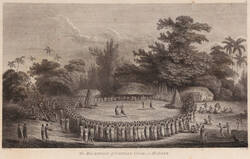Further Media
Producer unknown to us
Oceania, Polynesia, Tonga Archipelago (Tongatapu, 'Eua, Nomuka or Lifuka/Ha'apai group)
Before 1781
Wood – club tree (Casuarina equisetifolia)
Acquired in 1773–74 or 1777 on Captain James Cook’s second or third expedition in the Pacific. It is yet unknown by whom the object was acquired.
Brought from Great Britain to Germany by Benjamin La Trobe, a Moravian working in London.
Inv. no. 68641
This Tongan war club with a square cross section is carved from the wood of the cassowary, the club tree (toa). These classic Polynesian war weapons were often not made in the Tongan archipelago itself because the club tree, with its extremely hard wood, was not very common there. Instead, Tongan carvers worked for centuries on the Fiji Islands, which were at times dominated by Tongans.
In general, the design of Tongan clubs shows a wide variety of forms, with details in the carving having special spiritual and genealogical significance, and in the strictly hierarchical order of the original Tongan society, suggesting the origin and rank of the owner within the aristocracy.
In the case of the war club from the Herrnhut Cook collection, for example, the notched triangles symbolize divine birds, representing the club owner’s descent from divine ancestors. The figurative representation of a heron – a sacred creature for the Polynesians, and the preferred residence of the ancestral gods – also supports this conclusion. However, it is only since the end of the colonial era in Oceania that the mostly abstract Polynesian symbolic design has been gradually deciphered, not least due to Indigenous people’s growing interest in the origins of their own cultural identity.
Some 250 years ago, Captain Cook and his fellow travelers had no idea that the indented wavy lines on the Herrnhut club symbolized the sea, or that the straight lines symbolized the horizon. Even less did they know that the combination of these abstract codes (kupenga) represented the mythological stories of the ancestral gods whose descendants the owner of the club considered himself to be. However, James Cook noted in 1773 the artisans’ “…ornamenting of which they spend much time.”
